Photo

Sonata for smoke, veils, Volvo sedan, man-made rain, piano and percussion /煙、べール、ボルボのセダン、人口雨、ピアノとパーカッションのためのソナタ
2020
HD video with stereo sound, pastel on light clay; video duration 6:00, objects dimensions 35 x 52 x 42 cm. / HDビデオとステレオサウンド、軽量粘土にパステル; ビデオの長さ6分、オブジェクトのサイズ35 x 52 x 42 cm
0 notes
Photo
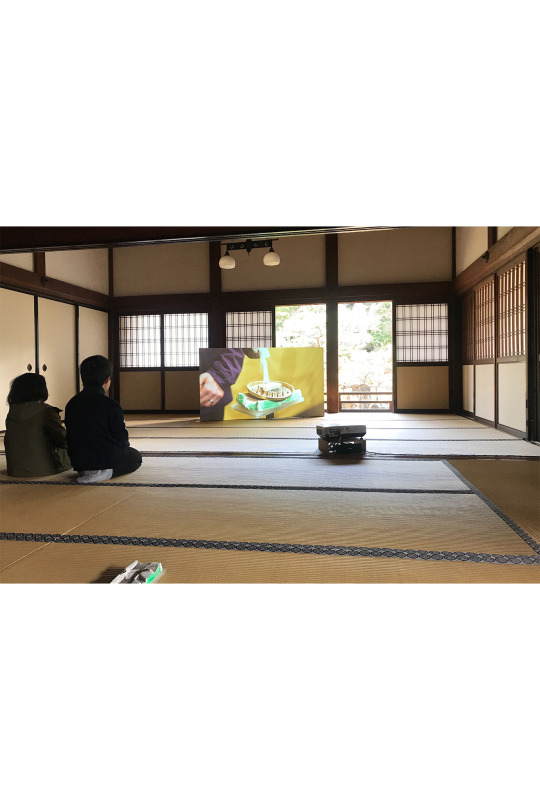
てらアート
期間中、建仁寺塔頭両足院の境内にて子どもたちの自習室「てらアート」として解放します。
・日時:3月9日、13日、16日、23日、27日、30日
10:00-12:00(受付9:45)
・対象年齢:10歳から16歳
・定員:1日3人
・時間割:10:00-11:00自習、11:00-11:30展覧会鑑賞、11:30-12:00感想文または絵の制作
・参加費無料
「てらアート」ご参加ご希望の方は、ご希望日3日前までに、
・名前
・学校名
・学年
・志望動機(参加ご希望の理由)
をご明記の上、メール([email protected])にてお申し込みください。
動機が不明瞭な場合は、ご利用になれない場合があります。予めご了承ください��
追って確認メールをお送りします。
0 notes
Photo
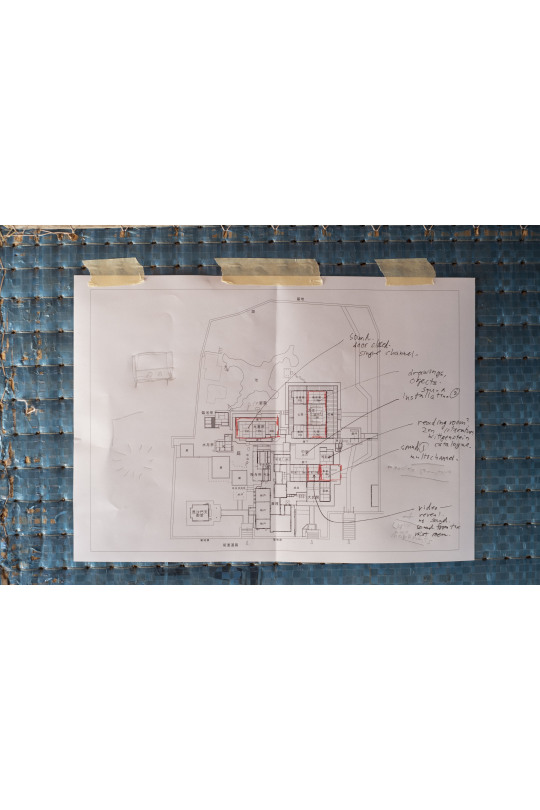
Exhibition Guide/ 展示図

1.Lieder ohne Worte
/ 無言歌集
2020
Pastel on 3d-printed PLA, 9-channels soundinstallation (speakers, fabric-wrapped cables, acrylic, custom-electronics);duration 25:52 loop.
/ 3DプリントPLA樹脂にパステル、9チャンネルサウンドインスタレーション(スピーカー、布巻きケーブル、アクリ ル、自作電子部品);長さ25分52秒ループ
2.Sonata for smoke, veils, Volvo sedan, man-made rain, piano and percussion
/ 煙、べール、ボルボのセダン、人口雨、ピアノとパーカッションのためのソナタ
2020
HD video with stereo sound, pastel on light clay; video duration 6:00, objects dimensions 35 x 52 x 42 cm.
/ HDビデオとステレオサウンド、軽量粘土にパステル; ビデオの長さ6分、オブジェクトのサイズ35 x 52 x 42 cm
3.Landschaft (Ryosoku-In)
/ 風景(両足院)
2020
Pastel, ink, stamp, colour pencil and water colour on paper; set of 18, dimensions 29.5x 21cm each.
/ 紙にパステル、インク、スタンプ、色鉛筆、水彩絵の具; 18点、それぞれのサイズ29.5 x 21cm
4.Reading Room
/ リーディングルーム
5.Tonight
/ 今夜
2020
1 colour pixel from the music video of SmashingPumpkin’s Tonight Tonight, computer-controlled LED colour light system, pastel and colour pencil on acrylic, pastel and colour pencil on plywood,3d-printed PLA, 3d-printed resin, interactive touch screens with custom-software, repurposed found objects (trumpet mouthpiece, silk flowers, NME035 ‘World Music’ cassette tape, Lupton & Miller Eds. the BauhausDesign Theory); set of 2, dimensions 24 x 18 x 9 cm & 28 x 12 x 63 cm.
/ スマッシング・パンプキンズ「Tonight Tonight」のミュージックビデオからワンカラーピクセル、コンピューター制 御カラーLED装置、アクリルにパステルと色鉛筆、合板にパステルと色鉛筆、3DプリントPLA樹脂、3Dプリント レジン、自作ソフトウェアによるインタラクティブタッチスクリーン、見出された再利用品(トランペットのマウスピ ース、造花、NME035「ワールド・ミュージック」のカセットテープ、ラプトン&ミラー編 「バウハウスデザイン理論」);2点、サイズ24x18x9cm& 28x12x63cm.
Photo: Nobutada Omote
写真:表恒匡
0 notes
Photo

アーティストQ&A
サムソン・ヤン:クロース・リーディング展を読み解くアーティストの言葉
キュレーター(以下Q):まず初めの二つの質問は、音とアートについてです。
サムソン・ヤン(以下A):それぞれで本が一冊かけそうです。
Q:数百ページくらいの!それぞれ一言ずつお願いします。
A:一般に音について話すとき、いつもそれは何か他のものと比べて考えられています。音対ノイズであったり、音対音楽、音対映像といった��うに。このことは、音というものが何か他のもの、でないものとしてしか考えられないことを示しているようです。私にとってはこういった対立は必ずしも正しいものではありません。とは言うものの、私は音を、ごくわずかでささやかな聴覚の経験、最も小さいあるいは最も密度の濃いレベルの経験であると考える傾向があります。
文章を話すとき、発せられる音声(発話)があり、そして建設と構築があります。発話を一つの文に構造化しようとし、文はその思考を伝達します。例えば、一本の鉛筆を落として一つの音をたてたとします。その音はほんの一瞬のものです。もし私が鉛筆を二度落とそうしたなら、それはパターンを生み出します。そしてそのパターンは、「鉛筆を二度落とすという意図」や「鉛筆を二度も落としてしまう注意力が足りていない私」といった他のことを伝えます。たった一つの特異な経験であった場合、その印象深さはより分かりやすいものとなります。しかし発話に対する思考を広げ、たった一つの文へ適応することでとり消そうとすることはまさに反対のことです。今朝の今この時、声の高低差といったことから私がどれだけ落ち着いているか、そうでないかを感じるために文を音の形として聞くことができます。つまり、私たちは、意味論的意味を伝達する文をただの音の形として捉えることが可能なのです。
これは聴覚のいつもの知覚経路をショートさせて、聴覚がどのように心のなかに意味を生み出すか、ということです。
Q:音とアートはあなたの作品において、関係があるものなのでしょうか。それともそうではない?
A:私がアートについて考える時、何か具体的な表現媒体について考えることは滅多にありません。媒体が専門的になる前の、人間の活動について言っています。それはもちろんもっと複雑なものですが。音というものはアートと同じではないけれど、アートに属するものです。アートはこの世界を包み込むほど大きいものであり、私がしていることや、誰か他の人がしていることに限定されるものではありません。
Q:3つめの質問はcomposing(作曲する、組み立てること)についてです。
A:私の目の前にあるこの机の上には、ものがそれぞれの要素として「構成された(composed)」状態できちんと置かれています。これらの要素は、特定の形状をなしています。ードローイングを描いているとまでは考えていませんがー私の好きなように並べられたこれらのものの構成には、リズムがあり、個々のものたちはお互いに対話をしている状態にあります。(鉛筆ケースを指して)これとこれはお互いに作用し合っています。(本とスケッチブックを指して)これらの二つはある意味無頓着に置かれていますが、お互いに一種の作用を与えあっています。(スタンプセットを指して)彼らがこちら側に置かれていることには「機能上の」理由がありますが、機能上の理由があるとしても、これららはなお、全体の作用の関係のなかにおかれている状態です。だから、構成する(composing)ということは私にとって、そういった意識的、無意識的、美的そして機能的なプロセスであり、同時に起こっています。
それらが現れたとき、文字通り彼らが「机の上に現れた」とき、それらをどのように置いたら良いのかわかるでしょう。机は土台となる枠であり、これら全ての異なる要素が会話の状態に入っているのです。それぞれのものたちは、その枠の中に様々なタイミングで、様々な理由によって入ってきます。私にとって作曲すること(composing)はそういったの全てのものが机の上にある状態のように、意味をなそうとする行為です。
私は音楽を作曲(compose music) します。しかしまた、ある空間に対して展覧会を制作するとき、言葉を組み立てるということ(word composing)もします。そしてどのようにその空間にものが共存するのかを考えます。コンサートホールで演奏される20分の楽曲はある特別なひとつの枠です。そして展覧会というものは単にまた別の枠であるのです。しかし、この枠というものは白紙の状態ではありません。このお寺(両足院)にはその形のうちにすでに何かしらあらかじめ存在しているものがあります。そしてギャラリーや美術館の展示室も、また別のものがあらかじめその形に備わっています。
Q:4つめの質問は空間についてです。空間と時間というようなことです。
A:それは私がどのように空間と時間を扱っているか、ということですか?
Q:わたしたちアートに関わる者にとって、空間と時間についての問題とは、人間あるいは小さなものとして存在することへの哲学的アプローチに関することです。あなたがアート作品を制作する際に空間と時間について、どのように考えていますか?
そして最後の質問は「クロース・リーディング」についてです。両足院での滞在についてどのように感じていますか?また展覧会はどのようなものになるでしょうか?
A:まだわかりません。展覧会がどのようなものになるかということですか?それとも今どのような感じかということでしょうか?
Q:実物としての作品を制作する前に、あなたの頭のなかでは「組み立てる(composing)」モードにあるのか、ということです。
A:なるほど、いいえ。全てのものが目の前に揃うその瞬間まで、完成した、と思うことはありません。ここ(両足院)での、私のプロセスについて話しましょう。私はここにいる間、ただただいろいろなものの断片を収集していました。しかしそれはなかなか複雑です。収集するという行為の裏にはいつも、自分がなにを収集するかに制限をかけるような指向があります。実際、ある瞬間が訪れるまで、私はそういった指向性から逃れられなかったのかもしれません。別の言い方をすれば、私はどのようにして先入観を取り払うのかわかりません。ものが目の前に現れるまでは知りようがないのです。どういうことかわかるでしょうか。私は収集をしています。そして自分自身に驚くことがあります。例えば、サールナート(ブッダが初めて説法を行なった地)を訪れたときに私は金箔が貼られたレンガの壁を見ました。そしてそのレンガの壁のイメージが頭から離れませんでした。そのことが、この場所で粘土を使ったレンガ状のものを制作しよう、という決断に至らせたのです。
しかし後日、私はこれらの粘土ででてきたレンガ状のものたちを、土嚢のように考えていることに気づいたのです。軍隊が用いるような土嚢です。「ああ、今はレンガの壁と言うより、土嚢の壁に見える」と思いました。その過程にはっとし、驚いたときに、自分の持っていた先入観が正しくなかったことに気づきます。しかし先入観と戦い続けたとしても、先入観からのがれられるわけではないのです。私は先入観を空間を扱うのと同じように扱います。それはもちろん、制限ともなりえるのですが。あなたがいっていることを私は理解していると思います。
あなたはピアノを弾いたことがありますよね。音階を練習するのは楽しいですか?
Q:聴くことと弾くことを同時に楽しんでいました。単に曲を弾くだけということではなく、曲を聴いて、味わい、この曲を作ったとき、作曲家がどのようなことを感じていたかを考えることに喜びを感じました。
それは…単に楽器を弾くと言うのではなくて、空間と時間の中で生み出したものを鑑賞するようなことです。つまりすべては、空間と時間に関して考えることであり、生きることについてやアートを創造することについても考えることなのです。
自分の存在と、そこに共存する美の間に調和を感じることは、一種の芸術体験であると言えると思います。私にとっては、美しいアート作品を鑑賞する行為や美しい自然の中にいること、例えば明け方や夕暮れ時に森の中にいること、それらは同じなのです。森自体が美しいからという理由ではないかもしれません。空気と音、光や闇そして土といったものによるものです。
五感は全てを感じていて、音楽、ピアノを味わうのと同じことだと思います。でももしどのように演奏すればいいかに集中しすぎると、それは苦しいのではないでしょうか。しかし突然に、喜びを感じる瞬間が訪れるのだとおもいます。あなたがどれだけ厳しい練習を積んできたのか想像がつきませんが。
A:でも、あなたは音階の練習に喜びを感じることはないですか?
Q:あなたにとってはどうですか?
A:音階が好きです。私は創造的な制約が好きなのです。そう思うのは、おそらく今の段階においてだけであろうことは確かです。ーいや、確かとはいえませんが、自分の人生における別の段階で、何か違うことが経験できることを願っています。
私はサンドボックス(砂場)をもっていて、その中でつくることができるものに集中することが好きです。
Q:これはまったく理にかなっていないかもしれないのですが、あなたと同じ空間にいると、例えば20人の参加者と一緒に���のワークショップの場にいたとき、言語やそれぞれが属する国の違いによる制約が感じられませんでした。ただ、制約のなさ、境界を感じる場合と同じようにその美しさを感じます。
一方で、新聞やテレビのニュースを通して今何が起きているのか見れば、それは戦争のことであったり、選挙のことであったり、誰が勝って誰が負けたかという話題ばかりです。創造の世界に身を置いていると、生きていて、ともにわかちあい、喜びのある自然な世界を感じます。それは私たち皆が必要とするものです。私たちは皆、幸せや平穏を求めているはずですが、なぜ人々は苦しまなければならないのでしょうか。芸術は生きるために苦しむ必要があるもしれず、もしかしたら貧しいのかもしれません。しかし裕福な人もいます。苦しんでいる人もいます。
どのようにして苦しみを乗り越えるか、私が芸術世界のなかで生きるということを選択したのは、幸せを見つけ出すためでした。今現在生きているアーティストと一緒にいることは人生において素晴らしいと感じることの一つです。あなたが音楽を演奏するときに喜びを感じるのと同じように。
あなたは、幸せ、美しさというものにおける自身の価値を人と分かち合っているのだと思います。常に「私は幸せを分かち合っているのだ」と思っている必要はないかもしれませんが、あなたはそのことを自然におこなっているようです。私はそれを美しい、と思いこの展覧会はあなたの美に対する価値を分かち合う機会になるのではないか、と考えています。これは考えすぎでしょうか?
A:そこまで大きなことを考えてはいません。制作しているとき、大半の時間は「これは私が作ったもの、これはその過程で考えたこと」といった感じです。それはスープ、であり「これが私の頭の中で起こった全てのことです」といった感じです。
Q:私が初めてみたあなたの作品は「音を消した状態」でした。
A:「音を消したオーケストラ」ですね。
Q:個人として対面したとき、わたしはあなたの作品に対するのと同じ感覚をあなたに対して抱きました。あなたはとても誠実で、文化がもつ価値を尊重します。そしてあなたの作品はそれを体験させてくれます。多くの人が、あなたに個人として直接会うということはできないかもしれませんが、作品を通して知ることができると思います。
A:ありがとうございます。でもそれらのことがどのように効果をもたらしているかは実際わかりません。世界にむけて「不快な音楽を解き放つこと」をして、その音楽が苦しみや混乱を巻き起こすということがあるのでしょうか。自分がそう信じているのかはわかりません。アートが人々に何らかの影響をもたらしていると「信じて」いないわけではありませんが。アートはもちろん人々に影響をもたらしています。ものごとを認識する際に、人は問題となっているそのものごとの一部となり、それらとお互いに作用しあいます。だから、当然のことながら、(壁に立てかけられた畳を押して)私がこれを押しているときとおなじように、ものごとは何らかの影響をあなたに与えています。同時にわたしは畳自体に影響を及ぼしています。しかしながらこれはとても特殊な関係性です。心理的な関係性や精神的、感情的な関係性もあるでしょう。
倫理的なことを、言い換えるならよりよく生きるにはどうしたら良いかまたはその逆のことを、そういった関係性から直接学ぶことが可能なのか私には確信が持てません。これが、まず第一に私にとってわからないことです。第二にわからないのは、もしアートというものが、作り手や見る人に対して生きている実感をもたらす、というとても特殊なことを成すものだとしたらー私はそう信じているのですがーなぜ私たちは混乱や不快感を避けようとするのか、ということです。アートは人に活力をあたえ元気付けることができますが、同時に、人を混乱ささせかき乱すことも等しく可能です。そしてそれらの状態は全て、私に生きている実感を与えます。アート自体がどのように判断を下すのかわかりません。私たちはもしかすると日常生活の中で苦しみとみなされるであろう混乱や、ネガティブな感情から逃れたいのかもしれません。しかしアートがそうさせたいのかはわかりません。アートはそうしてくれませんが、より生きていると感じることは、味わった感情がいかなるものであれ、瞬間的に苦しみから救ってくれるのだろうと思います。
私がこの前あなたに送った、とてもカオスなスラヴォイ・ジジェクの仏教についてのポッドキャスト*をすでに聴いたかはわかりませんが、彼は仏教と苦しみについて話していました。彼が仏教について理解できていないこととして苦しみから逃れたいという願望をあげていました。彼が引き出していたのはごく日常的な例です。あなたがすでに乗り越えた、けれど当時は苦しい思いをした恋愛について考えみてください。もし相手を本当に愛していたのであれば、その愛が真実のものであったなら、そのときにいかに苦しんで傷ついたとしても、再び誰かを愛してしまうでしょう。もちろんそれは、痛みや苦しみを繰り返すことですが、それが教えてくれることは何かあるはずです。共感するということです。私が一番好きな作家の1人であるアイリス・マードックはかつてこう書いていました。
アートが教えてくれる、もっとも価値のあることの一つは、何かを創造する経験によって他人への共感をしやすくしてくれることである。なぜなら、創造する行為一つ一つの背後には自分が持っているのとは異なるそれ特有の意識があり、その意識をもつものにとっての苦しみは創造するという行為のなかでこそ知ることができるのだから。
「音を消した状態」シリーズはひとつの意図のもと作られた唯一の作品かもしれません。そのほかの私の作品はすべて、もっと「スープのような」ものになることが多いです。これは自分でもいまだに解明しようとしていることです。
Q:ここまではインタビューのための質問でしたが、あとひとつ、スピンオフとして、この2週間の滞在中、バッハとヴィトゲンシュタインについて言及することが何度かあったかと思います。このお寺にいることと仏教寺院のなかでバッハを感じることがどのようなことであったか、教えてください。
A:ここでの滞在中、自分自身と言語との関係を学び直そうとしているように思います。
言語をとおして、実際どれくらい思考を伝えることができるのか、自分が言っていることは自分の心とつながっているのか、そういった問いです。ヴィトゲンシュタインの「Project」についても考えていました。彼はProject全体で我々は昔からある哲学と生きていると言っています。私たちが哲学に固執していることは未来を見据えてのことなのだとしたら、ヴィトゲンシュタインは今やそれは必要ないと言っていて、禅仏教は、私たちがそれを必要としたことはなかったと伝えようとしているのだと思います。
今の時点で、結論はだせません。今も考えています。ユダヤ教とキリスト教の教えは私たちが自分自身でそれをすることができないと理解させてくれます。それはわたしたちは脆いのだ、と言っているのです。自分が脆い存在であることはわたしにとって理解しやすいことですが、このお寺でまさに今経験していること全てと浅いながらも私の禅仏教の知識との関わりにおいて考えてきたことは、この世界においてほかのものとともに存在するのにより良い考え方であるかもしれません。しかしここで言う世界は私を必要としていません。私は「自分」でいることを諦めることができるのかわかりません。自分でいることが本当に楽しいのです。
注*:
The Buddhist Ethic and the Spirit of Global Capitalism (2012)
https://podcasts.google.com/?feed=aHR0cDovL3ppemVrcG9kY2FzdC5jb20vY2F0ZWdvcnkveml6ZWsvZmVlZC8&episode=aHR0cDovL3ppemVrcG9kY2FzdC5jb20vP3A9MTIz
サムソン・ヤン
2013年にプリンストン大学にて作曲の博士号を取得。多角的な表現を行うアーティスト/作曲家。2017年、第57回ベネチアビエンナーレに香港代表として参加したほか、近年はパフォーマ19(ニューヨーク/2019年)タルボット・ライス・ギャラリー(エジンバラ/2019)、スマート美術館(シカゴ/2019)などで展示を行う。2019年アルス・エレクトロニカ賞優秀賞(サウンドアート、デジタルミュージック部門)、2015年BMW アート・ジャーニー・アワード、2013年香港芸術発展局 年間最優秀作家賞(メディア・アート部門)他受賞多数。
今後の展覧会の予定:アジア協会香港センター、CHAT(香港)、 Xcentric, CCCB, (バルセロナ)、森美術館(東京)、Kunstmuseum Bonn(ドイツ)、Monash University Museum of Art(メルボルン)
RYOSOKUアートプログラム「瞑想回廊 」#1 サムソン・ヤン(楊嘉輝)「クロース・リーディング」展
期間:2020年3月7日(土)ー4月5日(日) 休館:火・水・木曜日、3月20日 時間:午前11時から午後3時(最終入館午後2時半) 場所:建仁寺塔頭両足院(京都市東山区大和大路四条下る4丁目小松町591) 鑑賞料:大人2,000円、学生1,000円(拝観料込) 事前予約専用ウェブサイト:reserva.be/ryosoku2020closereading
主催:RYOSOKU 企画・制作:TOMORROW 協力:Galerie Gisela Capitain RYOSOKU事務局 e-mail:[email protected] URL : ryosokuin.com/ryosoku/ キュレーター:徳田佳世(TOMORROW) 制作:橋詰隼弥、高橋あかね(TOMORROW)
翻訳:高橋あかね、校正:池上カノ
設営協力:スーパーファクトリー、ADF・アヤベ 写真:表恒匡
0 notes
Photo
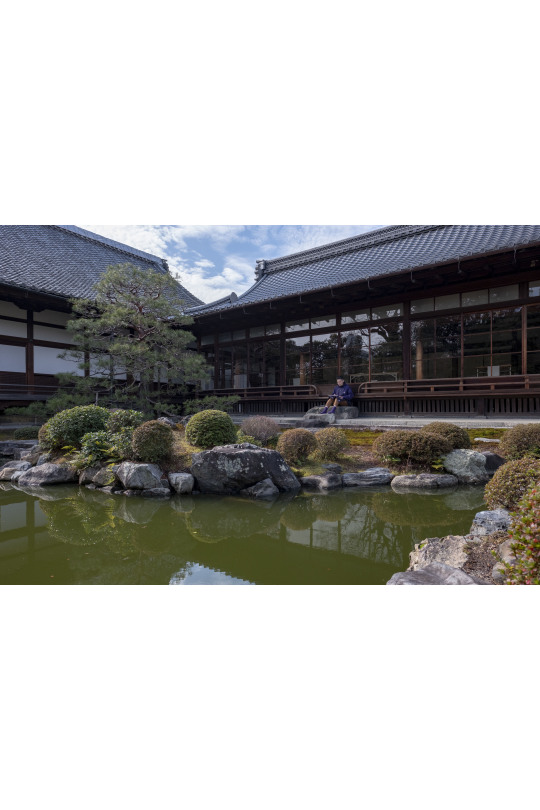
Artist Q & A
About SAMSON YOUNG: CLOSE READING A Dialogue
Curator (Q): The first two questions would be about sound and art.
Samson Young (A): I mean each of those questions could fill a book.
Q: Ready for hundred pages! In one word for each.
A: When we talk about sound, we are always thinking about it in opposition to something else. For example, it’s either sound versus noise, or sound versus music, or sound versus visual. It seems that we are only able to think about sound in opposition to something else. For me, these oppositions are not necessarily true. That said, out of habit, I too do tend of think of sound as the discreet moments of the experience of hearing, the smallest level or the most intense level of the experience. When you talk in sentences, there are the utterances, and then there are construction and structure. A sentence carries the thought that tried to structure utterances into a sentence. Take for example, if I made a single sound by dropping a pencil, that sound is a split moment, beep. If I decided to drop a pencil twice, then that generates a pattern and that pattern carries with it some other stuff in it, such as “the intention of dropping the pencil twice,” or, “me being careless which caused the pencil to drop twice,” you know. Whereas when it’s just one singular experience, the intensity of the experience is more accessible. But this is precisely the opposition that one can try to undo by expanding the thinking about that singular utterance and applying it onto even a sentence. So, it is possible to hear a sentence as shapes of sound, as the rise and fall of my voice, to perceive the quality of how calm or not calm I am on this particular day in the morning. So, in the end, your mind is capable of turning a sentence that carries semantic meaning into just shapes of sound. It’s a kind of short-circuiting of the usual pathway of hearing, and how hearing generates meaning in the mind.
Q: Is sound and art related to your work, or it’s separated?
A: When I think about art, I don’t really think about any particular medium. We are talking about a human activity before it became professionalized into mediums. Then of course it’s more complicated, right, sound is not equal to art, but sound is of art, and art being this much larger thing that exists out in the world that is not limited to what I do, or what any one person does.
Q: My third question is about composing.
A: I have in front of me on my table a very specific arrangement that is “composed” of individual elements, and together, these elements give specific shapes. And although I am probably not—I mean I was not thinking that I was making a drawing—but in the way that I am laying things out, in the particular order that I prefer, there is a rhythm, and the individual elements are in conversation with each other. (Referring to a case of pencil) like this piece is in conversation with this piece, (referring to a book and a drawing pad) these two things although they were laid out sort of casually, they have a sort of conversation with each other. There is a “functional” reason why these guys (referring to the stamping kits) are on this side, but even serving just a functional reason, they still participate in the overall conversation. So, composing for me is all those conscious, unconscious, aesthetic, but also functional processes all acting simultaneously. When they come to you, literally, when they “come to the table,” you find a way for them to be in an arrangement. The table is a container. The form is the way by which all of these different elements are in conversation. Elements enter into the form at different times, and for various reasons, and composing for me is trying to make sense of all those elements make sense as they come to the table.
I compose music, but I also use the word composing when I am making an exhibition in a space, and thinking about how things co-exist in that space. A 20 minute musical composition in a concert hall is a specific sort of container, and an exhibition is just another kind of container. But these containers are not blank slates. This temple comes with something that is already pre-given in its form, and a gallery or a museum space comes with another set of pre-given as forms.
Q: My fourth and the last question that I was thinking, the fourth question about space I mean like space and time.
A: You mean how I treat space and time?
Q: If we as people in art talk about the space and time issue, it is about the philosophical approach on being a human or little things and how you consider space and time when you create works of art. And of course, the last question is on “close reading”. How do you feel about the residency and how the exhibition is going to turn out?
A: I don’t know yet. You mean like what the show is going to be, or how is it feeling to me now, or...
Q: I mean whether if you are at the composing part in your mind before making the work physically.
A: Right, no, but I don’t think it is over, right, until the moment everything is in front of us. Let’s talk about my process here at the temple. I am just collecting scraps of things while I am here. But it’s also more complicated than that: behind the act of collecting, there is always already a direction that limits what I collect. It’s true. But I don’t know if I could ever get away from that directedness until the moment comes. Put another way, I don’t know how to get away from preconceived notions until I know what these notions are, and that I wouldn’t know until the thing is in front of me. You know what I mean? Like, I am collecting, and then sometimes I am surprised by myself. So, for example, it is because I saw a brick wall with gold leaf when I was in Sarnath (where Buddha gave his first sermon), and that image of that brick wall stuck with me, which is driving the decision to make the clay brick pieces here at the temple. But then the other day I caught myself thinking about these clay bricks as sandbags, you know, like military sandbags. I thought, “oh they look a little bit more like sandbags=walls to me now than they looked like brick walls”. And so, you are surprised by the process, and in that moment of surprise you realize the falsehood of your preconception, but if I am busy fighting preconceptions instead of being involved with the process, that’s not the way out of preconceptions. So, I deal with preconception in the same way that I deal with space, like that. But yes, that could well be a limitation, I think I know what you are talking about.
You play the piano, right, do you enjoy practicing scales? When did you enjoy it, as opposed to when did you not enjoy practicing scales?
Q: Like I felt joy of listening and playing at the same time, not just about playing but also listening and appreciating the note and thinking about how the composer felt when he or she made that music. It’s more about...not about just playing the instrument, it’s about appreciating the creation in space and time. So, it’s all about thinking about space and time and about living life and also the creation of art. And if I felt – whenever I feel the harmony between this existence and beauty existing together and then I think we can say it’s a kind of experiencing of art, and appreciating a beautiful work of art is the same for me personally as being in the beautiful nature, like in the forest at dawn or twilight. Maybe that’s not because the forest itself is beautiful. It’s about the air and the sound, the light and darkness and the soil. I think that your five senses feeling everything and I think it’s the same things for appreciating music or piano. But if you were so concentrated on figuring out how to play, it’s just – it’s struggling right. But suddenly I think it happens, you feel the joy. I don’t know how intense you’d have to practice.
A: But do you feel joy practicing scales?
Q: How is it like to you?
A: I like scales. I like creative limitations. Maybe that’s just the stage that I am at, I am sure —well I can’t be sure—but I hope that I will experience something different at a different stage of my life. I like having a sandbox, and then focusing on what I can make within that sandbox.
Q: It may not make sense at all, but being in the same space as you, like inside this workshop with 20 other people together I feel there is no limit between the languages or different countries that each of us belongs to. I just feel limitless, the beauty of feeling limitless like feeling the boundary, but whenever you see the newspapers or TV on the news on what is going on, it’s all about war, it’s all about competitions, and who won who lost. And being in the creation world you feel the nature of living, sharing, joy and that’s all we need. We are all trying for happiness and peace, but why do people have to suffer? The arts have to suffer just to live and may be poor, but some people are wealthy and have sufferings. How to get over suffering, and personally choosing art in life was to find the happiness and I think being with living artists is one of the good things about life, like you feel the joy as you are playing the music too.
So, I think you are sharing your value on happiness or beauty. Maybe you don’t need to think about it all the time—“I am sharing happiness”, but I think you are naturally doing it. I think, I find that is beauty and I think that this exhibition is going to be an opportunity to share your value about beauty, or am I thinking too much?
A: I am not thinking that big. When creating, most of the time I am just like, “this is the stuff that I made, and this is what I was thinking about approaching it.” It’s literally a soup, like saying, “here is everything that is going on in my head.”
Q: But when I experience your work for the first time that was Muted Situation.
A: Muted orchestra, yes.
Q: And meeting you in person I have the same kind of feeling about your work. You are very sincere and appreciate the value of culture and your work allows us to experience it. And so many people may not be able to see you in person, but through the works I think they still can.
A: Well, thank you. But I don’t know how these things work really. I mean, is there such a thing as “unleashing ugly music” into the world and have that music cause suffering or confusion? I don’t know if I believe in that. It’s not that I don’t “believe” that art does something to people, of course it does. In one’s perception of things, one become a part of the things in question, in that one interacts with those thing, right. So of course it does something to you, in the same way that I am pushing this (pushes a tatami mat), and I am doing something to it. But it’s a very specific kind of relationship. There are also psychological, mental and emotional relationships.
The thing that I am not sure about is whether these relationships can directly teach us anything about ethics, in other words, how to live better or vice versa. That’s the first thing that I am not sure about. The second thing is that if art does this one very specific thing, which I do believe in, which is that it makes one feel alive when one is making or experiencing it, then my question is, why do we want to avoid confusion, or ugliness? Art can leave one feeling revitalized and energized, but it is equally capable of leaving one feeling confused and agitated, and all of these states make me feel alive. So, I don’t know if art itself makes a judgment that way. We might want to in our daily life avoid confusion or negative emotions, which we might categorize as suffering, but I don’t know if art wants to do that. It doesn’t try to give you that, but feeling more alive, in and of itself, through whatever emotions you experience, would do something that would to deliver you from that suffering momentarily.
I don’t know if you’ve had the opportunity to listen to the very chaotic Zizek on Buddhism podcast that I forwarded to you. He was talking about Buddhism and suffering, and he said that the one thing that he doesn’t understand about Buddhism is this desire to get away from suffering. The example that he used was very every day: imagine a love affair that you have already gotten over that was painful at the time. If you really did love, as in, if the love was real, then even if you were suffering at the time, you would do it all over again. That of course is a cycle of suffering and pain, but that in itself teaches something, too, which is, the lesson of empathy. Iris Murdock, one of my favorite writers, once said that this is one of the more valuable lessons that art teaches – which is that when one experiences an act of creativity, it makes it easier for one to imagine the Other, because behind each act of creation there is a peculiar consciousness that is different to your own, and this conscious being’s specific predicaments are perceivable in the act of creation itself.
I think the Muted Situation series is maybe the only thing that I have made that has a single-mindedness about them. All of my other works tend to be more “soup-like.” It’s something that I am still trying to figure out.
Q: I think this is it for the interview, but as a kind of spinoff, I have a question that in the past two weeks or so, I think you sometimes mentioned about Bach and Wittgenstein and how do you describe being in this temple and feeling Bach in the Buddhism temple?
A: I think I am trying to relearn my relationship with language during my time here. How much thoughts can language really get across; is what I am saying connected to my mind, those kinds of questions. I am also thinking about the “project” of Wittgenstein. His whole project is basically saying that we have outlived philosophy. If our attachment to philosophy is about holding onto a way of looking into the future, Wittgenstein is saying we don’t need it now, and I guess Zen Buddhism is trying to tell us that we have never needed it.
I think I have no conclusion, at this moment, I am still thinking. I think Judeo-Christian thinking makes it easier for us to realize that we can’t do this on our own, which is a way of saying that we are vulnerable. Realizing that I am vulnerable is an easier thing for me, whereas this whole experience that we are in right now, at this temple, and everything that I have been thinking about in relation to my very shallow knowledge of Zen Buddhism is probably a better way of being with each other in the world, but it is a world that doesn’t need me in it. I am not sure if I am ready to give up “me” yet, because being me is really fun.
Q: Thank you.
Samson Young
Multi-disciplinary artist Samson Young was trained as a composer, and graduated with a Ph.D. in Music Composition from Princeton University in 2013. In 2017, he represented Hong Kong in a solo project at the Hong Kong Pavilion of the 57th Venice Biennale. He has recently presented in Performa 19, New York (2019); Talbot Rice Gallery, Edinburgh (2019); SMART Museum, Chicago (2019); Centre A Vancouver International Centre for Contemporary Asian Art (2019); and De Appel, Amsterdam (2018/19). His upcoming projects include presentations at Asia Society Hong Kong Center and Center for Heritage and Textile, Hong Kong; Xcentric, CCCB, Barcelona; Mori Art Museum, Tokyo; Kunstmuseum Bonn, Germany; and Monash University Museum of Art, Melbourne. He was the recipient of the BMW / Art Basel Art Journey Award, Hong Kong Arts Development Council Artist of the Year Award, Prix Ars Electronica Award of Distinction.
Samson Young: Close Reading
Date : Saturday, March 7 - Sunday, April 5, 2020
(Closed on Tuesday, Wednesday, Thursday and March 20)
Hours : 11am - 3 pm (last entry by 2:30pm)
Place : Ryosoku-in Temple in Kenninji Temple (591 Komatsu, 4 Yamatooji Shijo-sagaru, Higashiyama-ku, Kyoto)
Admission : Adult 2,000 yen, Student 1,000 yen
Reservations website : reserva.be/ryosoku2020closereading
Organized by:RYOSOKU Art Program “Meditation Corridor”
Curated and produced by:TOMORROW
Cooperation:Galerie Gisela CapitainInquiries
Inquiries (e-mail):[email protected]
URL : ryosokuin.com/ryosoku/
Curator: Kayo Tokuda (TOMORROW)
Office Staffs: Shunya Hashizume, Akane Takahashi (TOMORROW)
Cooperation for installation: Super Factory, ADF Ayabe
Photo: Nobutada Omote
0 notes
Text
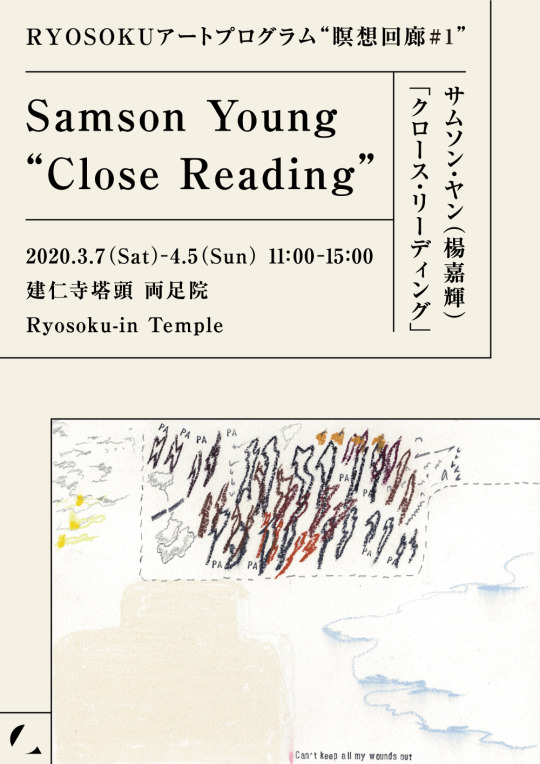
日本語 English
0 notes
Photo
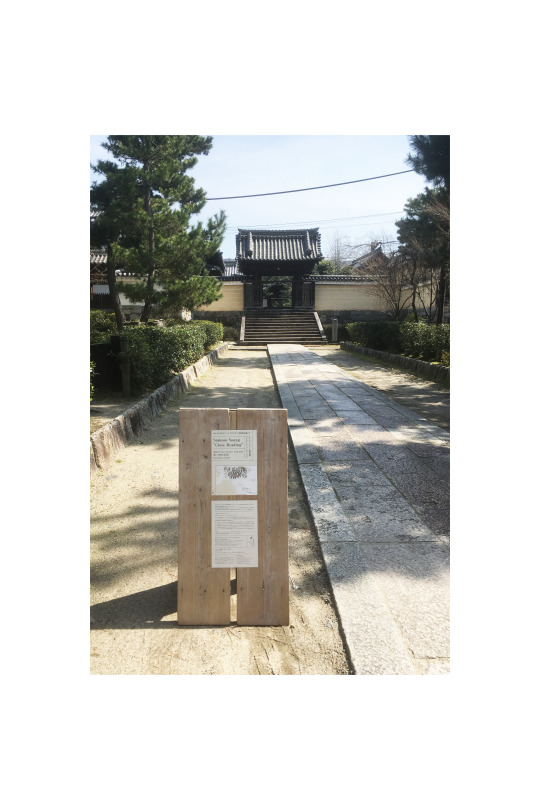
Venue / 会場
Ryosoku-in Temple in Kenninji Temple (591 Komatsu, 4 Yamatooji
建仁寺塔頭両足院(京都市東山区大和大路四条下る4丁目小松町591)
0 notes
Photo
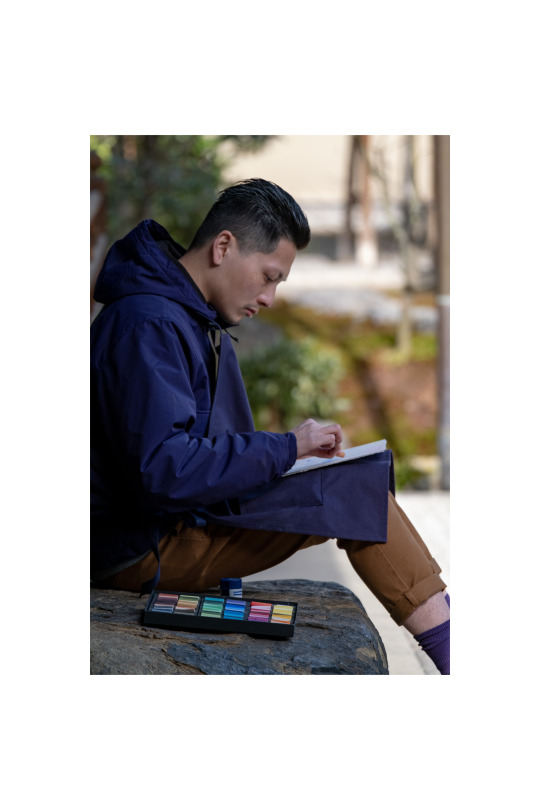
Artist bio / アーティストについて
Samson Young
Multi-disciplinary artist Samson Young was trained as a composer, and graduated with a Ph.D. in Music Composition from Princeton University in 2013. In 2017, he represented Hong Kong in a solo project at the Hong Kong Pavilion of the 57th Venice Biennale. He has recently presented in Performa 19, New York (2019); Talbot Rice Gallery, Edinburgh (2019); SMART Museum, Chicago (2019); Centre A Vancouver International Centre for Contemporary Asian Art (2019); and De Appel, Amsterdam (2018/19). His upcoming projects include presentations at Asia Society Hong Kong Center and Center for Heritage and Textile, Hong Kong; Xcentric, CCCB, Barcelona; Mori Art Museum, Tokyo; Kunstmuseum Bonn, Germany; and Monash University Museum of Art, Melbourne. He was the recipient of the BMW / Art Basel Art Journey Award, Hong Kong Arts Development Council Artist of the Year Award, Prix Ars Electronica Award of Distinction.
サムソン・ヤン
2013年にプリンストン大学にて作曲の博士号を取得。多角的な表現を行うアーティスト/作曲家。2017年、第57回ベネチアビエンナーレに香港代表として参加したほか、近年はパフォーマ19(ニューヨーク/2019年)タルボット・ライス・ギャラリー(エジンバラ/2019)、スマート美術館(シカゴ/2019)などで展示を行う。2019年アルス・エレクトロニカ賞優秀賞(サウンドアート、デジタルミュージック部門)、2015年BMW アート・ジャーニー・アワード、2013年香港芸術発展局 年間最優秀作家賞(メディア・アート部門)他受賞多数。
今後の展覧会の予定:アジア協会香港センター、CHAT(香港)、 Xcentric, CCCB, (バルセロナ)、森美術館(東京)、Kunstmuseum Bonn(ドイツ)、Monash University Museum of Art(メルボルン)
https://www.thismusicisfalse.com/
Photo: Nobutada Omote
写真:表恒匡
0 notes
Photo

Landschaft (Ryosoku-In)
/ 風景(両足院)
2020
Pastel, ink, stamp, colour pencil and water colour on paper; set of 18, dimensions 29.5 x 21cm each.
/ 紙にパステル、インク、スタンプ、色鉛筆、水彩絵の具; 18点、それぞれのサイズ29.5 x 21cm
Photo: Nobutada Omote
/ 写真:表恒匡
0 notes
Photo
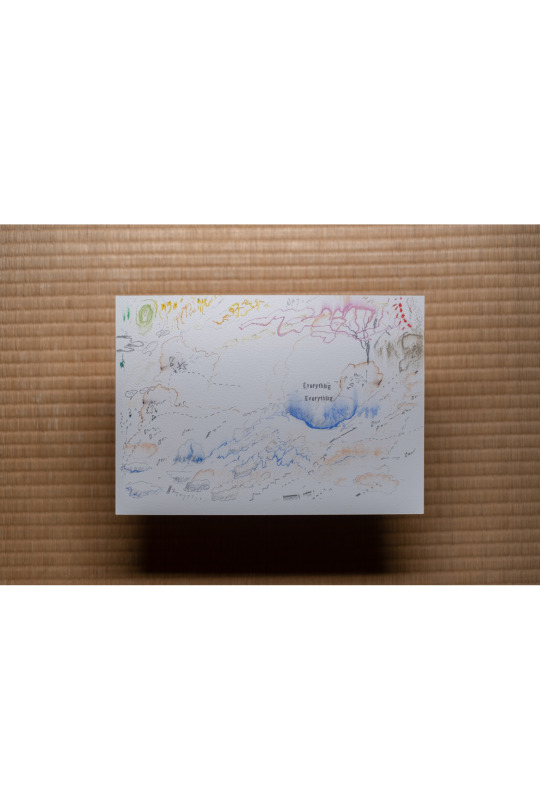
RYOSOKU Art Program
RYOSOKU Art Program”瞑想回廊”は、アジアのアーティストが両足院の歴史を踏まえ、未来に つながる現代の表現を制作、発表するアートプログラムです。 2020年3月より香港を拠点に活躍するアーティスト、サムソン・ヤンによる作品を公開します。 ヤンは制作にあたり、寺院に滞在、禅僧の暮らしを体験し、その環境と音に着目した新作「クロー ス・リーディング」を発表します。
RYOSOKU ホームページ: https://ryosokuin.com/ryosoku/
Photo: Nobutada Omote
写真:表恒匡
0 notes
Photo

Lieder ohne Worte
/ 無言歌集
2020
Pastel on 3d-printed PLA, 9-channels sound installation (speakers, fabric-wrapped cables, acrylic, custom-electronics); duration 25:52 loop.
/ 3DプリントPLA樹脂にパステル、9チャンネルサウンドインスタレーション(スピーカー、布巻きケーブル、アクリル、自作電子部品);長さ25分52秒ループ
Photo: Nobutada Omote
/ 写真:表恒匡
0 notes
Photo

Tonight
/ 今夜
2020
1 colour pixel from the music video of Smashing Pumpkin’s Tonight Tonight, computer-controlled LED colour light system, pastel and colour pencil on acrylic, pastel and colour pencil on plywood, 3d-printed PLA, 3d-printed resin, interactive touch screens with custom-software, repurposed found objects (trumpet mouthpiece, silk flowers, NME035 ‘World Music’ cassette tape, Lupton & Miller Eds. the Bauhaus Design Theory); set of 2, dimensions 24 x 18 x 9 cm & 28 x 12 x 63 cm.
/ スマッシング・パンプキンズ「Tonight Tonight」のミュージックビデオからワンカラーピクセル、コンピューター制御カラーLED装置、アクリルにパステルと色鉛筆、合板にパステルと色鉛筆、3DプリントPLA樹脂、3Dプリントレジン、自作ソフトウェアによるインタラクティブタッチスクリーン、見出された再利用品(トランペットのマウスピース、造花、NME035「ワールド・ミュージック」のカセットテープ、ラプトン&ミラー編 「バウハウスデザイン理論」); 2点、サイズ24 x 18 x 9 cm & 28 x 12 x 63 cm.
Photo: Nobutada Omote
/ 写真:表恒匡
0 notes